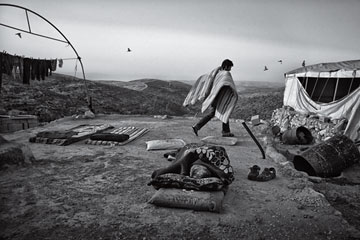
A Palestinian man wakes in the ruins of his family's West Bank house, destroyed by the Israeli army.
Two decades ago, the word Oslo evoked everything the Middle East normally refuses to provide: hope, trust and compromise. Israelis and Palestinians, two peoples claiming the same biblical lands, had rarely talked peace with each other before in a serious way. Then, in the space of four months, their leaders secretly agreed upon a set of plans — the Oslo accords — that promised an end, once and for all, to the violent conflict between them. The diplomatic achievement was sealed on the White House lawn on Sept. 13, 1993, with a signing ceremony and a handshake between Palestinian leader Yasser Arafat and Israeli Prime Minister Yitzhak Rabin.
The reality came home nine months later, in July 1994, when Palestinian guerrillas led by Arafat ended 27 years of exile by rolling into the Gaza Strip escorted by Israeli soldiers. "From the moment we entered Gaza, it looked like, my God, really peace has come," says Nabil Shaath, one of Arafat's lieutenants. "We were doing things fast."
The momentum ended on Nov. 4, 1995, when a radical right-wing Jewish settler shot Rabin dead at a peace rally in Tel Aviv. In that moment, many historians have argued, the Oslo accords suffered a fatal blow. Without Rabin to reassure a nervous Israel that Oslo was a genuine path to peace, extremists quickly began to drive events on both sides. Violence erupted in 2000, and Israel's peace camp was destroyed in the face of the ensuing wave of Palestinian suicide bombings. The center of Israeli politics shifted firmly to the right. The Islamist extremists of Hamas took control of the Gaza Strip. A physical barrier now keeps Palestinians who live in the West Bank out of Israel. Arafat died in 2004.
The "Oslo process" lived on, but the political stasis and physical facts on the ground confirm U.N. Secretary-General Ban Ki-moon's prognosis that the agreement is on life support. Two decades after the White House signing, Palestinians have less income, less land and much less freedom than they did in 1993. The 1.7 million residents of Gaza are not permitted to travel beyond the narrow strip of land. Israeli settlements in the West Bank and East Jerusalem have doubled the number of Jewish settlers living there since 1993. As Cédric Gerbehaye's photographs of Palestinians and Israelis living in the West Bank show, this is a land whose people are always on edge and often at blows.
With terrorist attacks in Israel a rarity, however, many Israelis see nothing to be gained from further negotiations with the Palestinians. "Israelis enjoy the status quo. There is no pressure, so why change anything?" says Menachem Klein, a left-leaning Israeli political scientist from Bar-Ilan University in Ramat Gan. But another round of U.S.-sponsored talks is nevertheless under way, with expectations that could hardly be lower on both sides. The goal is a final agreement taking in the difficult issues — including the question of who has sovereignty over East Jerusalem and how to address the demands of Palestinian refugees to return to homes in the West Bank or what is now Israel — that Oslo had deliberately avoided.
U.S. Secretary of State John Kerry, who has brought the sides together for these talks, observes that the broad outlines of a deal have been apparent for years — including land swaps, international supervision of Jerusalem's holy sites and compensation to refugees. But skeptics argue that the inability of the Israelis and Palestinians to come to final terms shows how reluctant both are to make the most difficult concessions. Twenty years on, hope, trust and compromise are no longer much in evidence.
